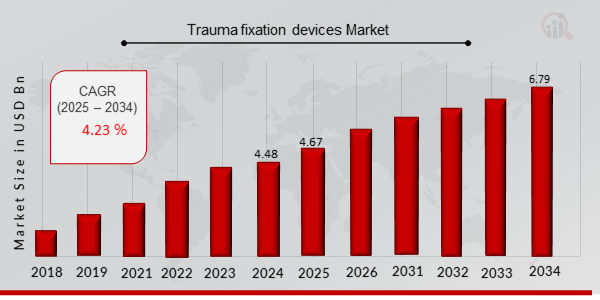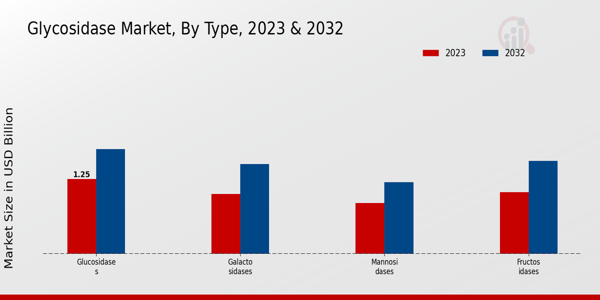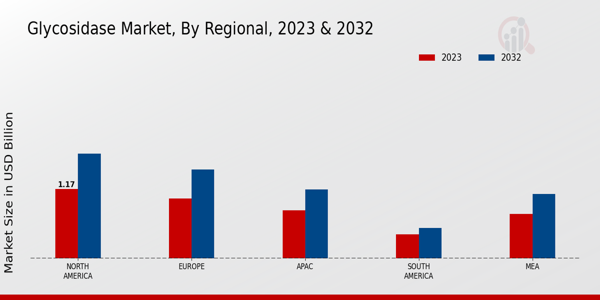Glycosidase Market Overview
As per MRFR analysis, the Glycosidase Market Size was estimated at 4.48 (USD Billion) in 2024. The Glycosidase Market Industry is expected to grow from 4.67 (USD Billion) in 2025 to 6.79 (USD Billion) till 2034, at a CAGR (growth rate) is expected to be around 4.23% during the forecast period (2025 - 2034).
Key Glycosidase Market Trends Highlighted
The Glycosidase Market is experiencing steady growth driven by a range of factors. The rising demand for biotechnology-based products in pharmaceuticals and nutritional supplements is a significant catalyst. With a growing emphasis on personalized medicine and advancements in drug formulations, glycosidases play an essential role in the development of therapeutic enzymes and biologically active compounds. Additionally, increased research activities across various domains, such as biochemistry and molecular biology, are enhancing the understanding and application of glycosidases, further propelling market expansion. Furthermore, there are numerous opportunities to be explored in the market, particularly in the field of enzyme replacement therapy.As more companies invest in research to discover innovative applications of glycosidases, there exists potential for novel treatments for diseases caused by enzyme deficiencies. The rise of personalized nutrition also opens new avenues for incorporating glycosidases into consumer products, thus benefitting various sectors like food and cosmetics. Moreover, expanding R activities in emerging markets provides additional growth prospects for businesses willing to expand their reach and influence. Recently, market trends indicate a shift towards sustainable and eco-friendly enzyme solutions. Companies are increasingly focusing on natural and less harmful production processes, in line with global sustainability goals.The development of smart technologies and automated processes in bioprocessing is also reshaping production techniques, leading to enhanced efficiency and reduced costs. As the demand for advanced therapeutics and personalized solutions continues to rise, the significance of glycosidases is likely to grow, positioning the market for further evolution and expansion in the years to come.

Source: Primary Research, Secondary Research, MRFR Database and Analyst Review
Glycosidase Market Drivers
Growing Demand for Glycosidases in Pharmaceutical Applications
The Glycosidase Market Industry is witnessing a significant surge in demand for glycosidases in various pharmaceutical applications. Glycosidases play a critical role in drug development and therapeutic applications, primarily due to their capacity to hydrolyze glycosidic bonds, which is pivotal in the metabolism of carbohydrates. The increasing prevalence of diseases such as diabetes, lysosomal storage disorders, and cancer has led to heightened interest in enzyme-based therapies.This growing focus on enzyme replacement therapies and biopharmaceutical products is driving the need for glycosidases that can ensure the efficacy of therapeutic agents. Additionally, the advancements in biotechnology and genetic engineering have enabled the development of more effective and specialized glycosidases, further enhancing their therapeutic potential. As a result, the rising initiatives for the exploration of glycosidases in pharmaceuticals are anticipated to significantly contribute to the expansion of the Glycosidase Market Industry in the forthcoming years.The increasing emphasis on personalized medicine and the integration of enzymes into drug formulations are anticipated to support this market growth, as they promise improved therapeutic outcomes and reduced side effects. Furthermore, collaborations between pharmaceutical companies and research institutions in the field of glycosidase research indicate a promising future for the incorporation of these enzymes into pharmaceutical products.
Rising Application of Glycosidases in Agriculture
The Glycosidase Market Industry is benefitting from the increasing application of glycosidases in agriculture, specifically in the development of bio-pesticides and bio-fertilizers. As the agricultural sector shifts towards sustainable practices, the demand for natural enzymes to promote plant growth and protect crops against pests is on the rise. Glycosidases are essential in facilitating processes such as cell wall formation and degradation in plants, which contribute to enhanced nutrient uptake and growth efficiency.The growing awareness of environmental concerns and the move away from synthetic chemicals are driving farmers to adopt biotechnological solutions, resulting in a robust market for glycosidases in agricultural applications.
Technological Advancements in Glycosidase Production
Technological advancements in the production and formulation of glycosidases are driving the Glycosidase Market Industry forward. Innovations in enzyme engineering, fermentation technologies, and purification processes have improved the efficacy and yield of glycosidases, thus making them more commercially viable. The integration of modern bioprocessing techniques enables manufacturers to produce high-quality enzymes at a lower cost, enhancing their accessibility to various industries such as food, pharmaceuticals, and biotechnology.Moreover, the ongoing research in enzyme stability and specificity is paving the way for tailored glycosidases that cater to specific industrial needs, which further boosts market growth.
Glycosidase Market Segment Insights:
Glycosidase Market Type Insights
The Glycosidase Market is projected to reach a valuation of 4.13 USD Billion in 2023, with further opportunities for growth evident as the market aspires for a valuation of 6.0 USD Billion by 2032. The market is characterized by its diverse segmentation, especially within the Type category, where various sub-segments play a critical role in shaping the industry's landscape. Notably, Glucosidases hold a commanding share of the market, valued at 1.25 USD Billion in 2023 and expected to rise to 1.75 USD Billion by 2032, showcasing its prominence and necessity in numerous applications such as pharmaceuticals and biochemistry.Galactosidases, with a valuation of 1.0 USD Billion in 2023 and an increase to 1.5 USD Billion anticipated by 2032, also demonstrate significant market presence due to their biochemical functions that support various metabolic processes. Meanwhile, Mannosidases, although somewhat smaller, still represent a key component of the market, standing at 0.85 USD Billion in 2023 with projections of reaching 1.2 USD Billion by 2032, driven by their application in glycoprotein research and development. Fructosidases contribute similarly, with a valuation of 1.03 USD Billion in 2023, expected to increase to 1.55 USD Billion by 2032, signaling their role in carbohydrate metabolism and potential therapeutic applications.Overall, the Glycosidase Market exhibits a healthy growth trajectory supported by the increasing demand for enzymes across various industry verticals, reflecting a blend of opportunities and challenges inherent to each Type. The diversity among these segments emphasizes a favorable landscape for future advancements and innovation, paving the way for enhanced functionalities in industrial and research applications. Market trends suggest that the rise in biotechnology and pharmaceuticals is likely to drive the growth of Glucosidases significantly, while the ongoing research within carbohydrate metabolism continues to elevate the significance of both Galactosidases and Fructosidases in the marketplace.Challenges such as regulatory compliance and technological advancements must be navigated to fully harness the opportunities presented within all segments. The dynamic nature of the Glycosidase Market and its segmentation underscores the essential role these enzymes play in contemporary science, healthcare, and numerous commercial applications.

Source: Primary Research, Secondary Research, MRFR Database and Analyst Review
Glycosidase Market Application Insights
The Glycosidase Market is expected to be valued at 4.13 USD Billion in 2023, showcasing an upward trend as it progresses towards 6.0 USD Billion by 2032. Within the Application segment, energy is drawn from its diverse areas, including Medical, Food Beverage, Detergents, and Animal Feed. The Medical application plays a vital role, utilizing glycosidases for therapeutic purposes, which significantly boosts market growth. Meanwhile, the Food Beverage sector significantly utilizes glycosidases for processing and enhancing flavors, thus capturing a substantial market share.The Detergents application is essential as it incorporates glycosidases for effective cleaning, pointing to the rising consumer demand for eco-friendly products. Lastly, the Animal Feed industry benefits from glycosidases to improve nutrient availability, fostering livestock health and productivity. These applications exhibit important growth drivers, such as the increasing focus on health and wellness, consumer preference for natural ingredients, and regulatory support for enzyme usage across various industries. The Glycosidase Market statistics reflect robust expansion, influenced by trends towards sustainability and innovation, paving the way for emerging opportunities and sustained market presence.
Glycosidase Market Source Insights
The Glycosidase Market, valued at 4.13 USD Billion in 2023, demonstrates a robust framework of growth driven by its diverse sources, which include Microbial, Plant, and Animal categories. Each of these sources plays a crucial role in addressing various industrial needs, contributing to the overall market growth. Microbial sources are particularly significant due to their efficiency and adaptability in biotechnological applications, which enhances the enzyme production process. Meanwhile, Plant sources offer a sustainable and eco-friendly alternative, supporting the rising demand for natural products in food and pharmaceuticals.Animal sources, although less dominant, remain important for specific enzymatic functions in specialized applications, ensuring the market accommodates a wide range of requirements. As the market progresses, ongoing advancements in biotechnology and increasing awareness of enzyme applications across industries are expected to provide ample opportunities for growth, all while navigating challenges such as regulatory approvals and market competition. The Glycosidase Market segmentation reveals critical insights into how these diverse sources collectively contribute to a more sophisticated and responsive market landscape.
Glycosidase Market Form Insights
The Glycosidase Market, valued at 4.13 USD Billion in 2023, is witnessing steady growth in its Form segment, which includes various forms such as Liquid, Powder, and Granular. Each of these forms plays a significant role in the application of glycosidases, with Liquid formulations being particularly favored for their ease of use in biological processes. Powdered forms are often utilized due to their concentrated properties, making them suitable for diverse industrial applications, while Granular forms dominate in sectors requiring slow release or controlled reaction times.These characteristics highlight the importance of each form tailored to meet industry-specific needs. The Glycosidase Market revenue growth is driven by factors such as increased demand in pharmaceuticals and environmental biotechnology, while challenges related to regulatory standards and high production costs persist. The Glycosidase Market industry also sees opportunities to expand its applications in food processing and biofuels, resulting in a dynamic market landscape. Overall, the segmentation within the Form category reflects a robust Glycosidase Market statistics framework that aligns with evolving market demands and trends.
Glycosidase Market Regional Insights
The Glycosidase Market is expected to show significant value across various regions, with North America leading the charge. In 2023, North America was valued at 1.167 USD Billion, reflecting a major share in the overall market dynamics. Europe followed closely with a valuation of 1.006 USD Billion, indicating its prominent role in the industry. The APAC region, with a valuation of 0.805 USD Billion, showcases considerable growth potential as increased research and development activities are underway. South America held a value of 0.403 USD Billion, which, although smaller, presents opportunities for expansion given the region's evolving healthcare landscape.Meanwhile, the MEA region, valued at 0.749 USD Billion, is witnessing a gradual rise due to increasing awareness about glycosidase applications. The market trends show that North America and Europe dominate due to their advanced healthcare infrastructure and investment in biotechnology, while APAC offers promising growth potentials as economies develop. Collectively, these regions contribute to the Glycosidase Market revenue, driven by applications in pharmaceuticals, agriculture, and food processing, presenting various growth drivers and challenges that are crucial to observe.

Source: Primary Research, Secondary Research, MRFR Database and Analyst Review
Glycosidase Market Key Players and Competitive Insights:
The Glycosidase Market has witnessed significant growth and evolution in recent years, driven by increased research and development activities, advancements in biotechnology, and rising awareness regarding enzyme-based therapies. As a crucial sector within the broader pharmaceutical and biotechnology industries, the market is characterized by a diverse range of products and applications, including therapeutic agents, diagnostic tools, and various biotechnological applications. Key players are competing to capture market share, focusing on innovation, strategic partnerships, and expanding their product portfolios. The competitive landscape is further influenced by regulatory challenges and the need for compliance with stringent quality standards. Companies are continually investing in technological advancements to enhance the efficacy and specificity of glycosidase products, fostering a dynamic competitive environment.Roche has established a strong presence in the Glycosidase Market, leveraging its extensive expertise in biochemistry and a robust research and development framework. The company focuses on developing innovative glycosidase-based therapies that address specific medical conditions, thereby enhancing patient outcomes. Roche's strengths lie in its commitment to quality, rigorous clinical testing, and strategic collaborations with academic institutions and research organizations. Through its comprehensive pipeline of glycosidase products, Roche aims to meet the growing demand for effective treatments and position itself as a leader in the enzyme therapy space. By prioritizing patient-centric solutions and advancing its scientific capabilities, Roche is well-positioned to navigate the competitive landscape of this market.Pfizer has also made significant strides in the Glycosidase Market, utilizing its vast resources and industry experience to develop a broad range of glycosidase products. The company harnesses its cutting-edge research facilities and extensive knowledge of enzymology to create therapies that effectively target various diseases. Pfizer's strengths lie in its global distribution network, allowing for widespread access to its glycosidase treatments. Moreover, the company places a strong emphasis on regulatory compliance and quality assurance, ensuring that its products meet the highest standards of safety and efficacy. Through continuous investment in research and collaboration with healthcare providers, Pfizer is committed to advancing the therapeutic potential of glycosidases while maintaining a competitive edge in this rapidly evolving market.
Key Companies in the Glycosidase Market Include:
-
Roche
-
Pfizer
-
Eli Lilly
-
Danisco
-
Merck Group
-
Fujifilm
-
Synlogic
-
Amgen
-
Novozymes
-
Zymeworks
-
Asahi Kasei
-
Genomatica
-
Amano Enzyme
-
Novartis
-
Boehringer Ingelheim
Glycosidase Market Industry Developments
Recent developments in the Glycosidase Market have showcased a significant emphasis on innovation and strategic partnerships. Companies such as Roche and Pfizer are actively pursuing advanced research to develop novel glycosidase-based therapies aimed at various diseases, including rare genetic disorders. Meanwhile, Eli Lilly and Merck Group continue to enhance their existing portfolios, with recent patents granted related to glycosidases in pharmaceutical applications. Meanwhile, Danisco and Novozymes are focusing on sustainable enzyme production, aligning their strategies with environmental concerns, potentially impacting market dynamics significantly. Moreover, Synlogic and Amgen are engaged in discussions for collaborative projects aimed at leveraging glycosidase capabilities for therapeutic solutions. In the realm of mergers and acquisitions, Boehringer Ingelheim has made headlines by acquiring a smaller enzyme-focused firm to bolster its capabilities in glycosidase applications, thereby strengthening its market position. As a result of these activities, the market valuation of companies in this space shows promising growth trends, which are anticipated to drive further investments and product developments as the industry evolves.
Glycosidase Market Segmentation Insights
| Report Attribute/Metric |
Details |
|
Market Size 2024
|
4.48 (USD Billion)
|
|
Market Size 2025
|
4.67 (USD Billion)
|
|
Market Size 2034
|
6.79 (USD Billion)
|
|
Compound Annual Growth Rate (CAGR)
|
4.23 % (2025 - 2034)
|
|
Report Coverage
|
Revenue Forecast, Competitive Landscape, Growth Factors, and Trends
|
|
Base Year
|
2024
|
|
Market Forecast Period
|
2025 - 2034
|
|
Historical Data
|
2020 - 2024
|
| Market Forecast Units |
USD Billion |
| Key Companies Profiled |
Roche, Pfizer, Eli Lilly, Danisco, Merck Group, Fujifilm, Synlogic, Amgen, Novozymes, Zymeworks, Asahi Kasei, Genomatica, Amano Enzyme, Novartis, Boehringer Ingelheim |
| Segments Covered |
Type, Application, Source, Form, Regional |
| Key Market Opportunities |
Rising demand in the pharmaceutical industry, Increasing applications in biotechnology, Growth in the nutritional supplements market, Expanding research in glycoscience, Development of enzyme-based therapeutics |
| Key Market Dynamics |
Increasing demand for biocatalysts, Expanding pharmaceutical applications, Growing food industry utilization, Rising R investment, Advancements in enzyme technologies |
| Countries Covered |
North America, Europe, APAC, South America, MEA |
Frequently Asked Questions (FAQ) :
The Glycosidase Market is expected to be valued at 6.79USD Billion in 2034.
The expected CAGR for the Glycosidase Market from 2024 to 2032 is 4.23%.
North America is anticipated to hold the largest market share, valued at 1.757 USD Billion in 2032.
By 2032, the market size for Glucosidases is expected to reach 1.75 USD Billion.
Major players in the Glycosidase Market include Roche, Pfizer, and Eli Lilly among others.
Galactosidases are expected to be valued at 1.5 USD Billion in 2032.
The APAC region is projected to grow to 1.157 USD Billion by 2032.
The market value for Fructosidases is expected to be 1.55 USD Billion in 2032.
Growing applications in pharmaceuticals and biotechnology present significant growth opportunities.
Mannosidases are expected to reach a market size of 1.2 USD Billion in 2032.

















